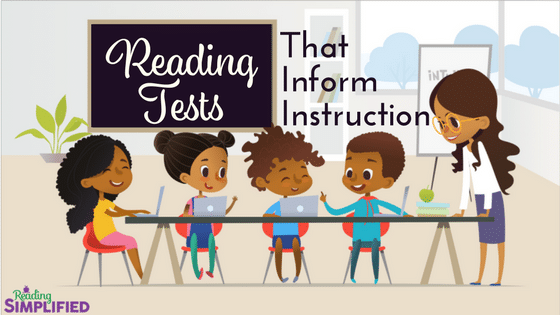
“Houston, we have a problem.”
Beyond the 2nd grade, most classroom teachers do not have access to specific assessment information about reading that can inform instruction. This is a big problem.
In the U.S., for instance, nearly 65% of 4th grade readers are NOT proficient in reading. Teachers of these struggling readers are likely aware that these students aren't “on grade level.”
However, they are rarely well-informed as to WHY their students aren't on grade level. We give yearly, and sometimes quarterly, comprehension tests, but these assessments do not explain where the students' reading weaknesses lie.
Comprehension tests merely give an indication of a child's overall reading ability or performance.
But these reading tests give almost no information to inform instruction!
Is the child behind because of:
- limited reading practice?
- poor decoding?
- lack of comprehension strategies?
- weak vocabulary knowledge, or
- poor word recognition?
These and other sub-processes are all possible causes of students reading achievement struggle. But a comprehension test alone will not determine which problem, or problems, are the root trouble.
Again, this is a problem. It's like we're sending out teachers out on the ocean near a rocky coast with no lighthouse for miles.
Or, it's like a doctor who diagnoses and prescribes on the sole information of a fever.
Is the fever caused by an ear-infection?
- The flu?
- From an infected cut?
- From advanced autoimmune weaknesses?
Just as we wouldn't want to travel without a lighthouse or have a doctor who diagnoses without understanding all the symptoms, classroom teachers need more refined tools in their toolkit to solve students' reading problems.
We need fewer outcome-based tests and more diagnostic-based tests if we want teachers informed for optimal reading instruction.
In this post, I will explain how 3 short tests can diagnose most students' reading needs. I'll also provide access to resources–including many free ones!!–that one can quickly put to use to solving students' reading challenges.
#1 Most Under-Utilized, Yet Urgent, Reading Test
When a teacher has concerns about a child's reading, or when an outcome-based comprehension test reveals that she is struggling, the teacher should have easy access to diagnostic measures that pinpoint the source of the problem–quickly.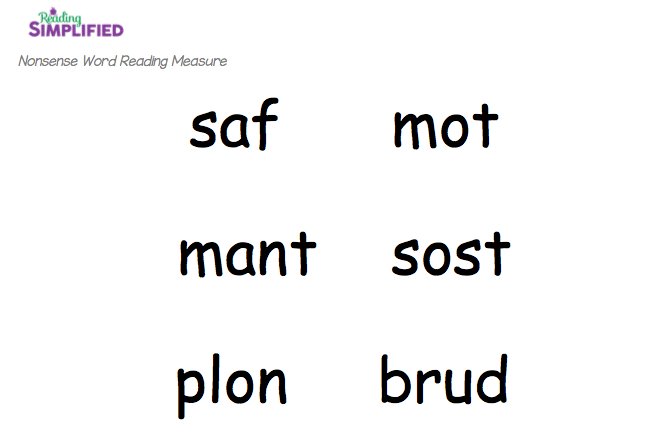
The #1 diagnostic test to track down the source of most reading problems in English is a nonsense word reading test. Why?
A nonsense (or nonword) reading test, like the one on the right, uncovers the reader's sound-based decoding ability. AKA, his phonological decoding ability.
Strong sound-based decoding lays the foundation for all other reading skills; thus, without it, trouble with reading pops up in all sorts of places. And these troubles often get identified as comprehension problems.
But, for a vast majority of students, the primary problem is simply poor sound-symbol decoding.
The nonsense word test picks up this weakness because the reader can't have seen these “words” before and previously memorized them, especially using inefficient visual approaches to word recognition.
As a result, when a teacher discovers that a student has poor sound-symbol processing, she then knows that the student's most pressing need for reading is to improve his sound-based decoding.
Other reading sub-skills, such as Word Identification, Fluency, Vocabulary Knowledge, and Comprehension strategies, are still important but the urgent need for those with weak sound-based decoding is to improve sound-based decoding. All the other skills build upon, for the most part, the foundation of strong sound-symbol processing.
Teachers, of almost every grade, who have access to standardized, norm-referenced tests of Word Attack or Nonsense Word Reading, such as the
- Woodcock-Johnson Reading Mastery Test or
- Wechsler Individual Achievement Test (Pseudoword Reading)
should consider giving that test as a screener for students who are not doing well in reading.
It will uncover a lot of surprising information!
99% of the students I have tutored over the last 20 years who have been identified as resistant, struggling, dyslexic, learning disabled, or Asperger's have had poor word attack when I began tutoring them.
After about 12 hours of tutoring with a focus on sound-based decoding, these students, on average, have above grade level outcomes in Word Attack. AND, their Word Identification, Fluency, and Comprehension scores go up significantly as well, usually to grade level or above.
FREE Nonsense Word Reading Tests
But many of us don't have access to expensive norm-referenced test, so I have 3 other FREE options:
- online-based, norm-referenced nonword and real word test Lexercise.com (most appropriate for readers under 4th-5th grade),
- online-based, criterion-based nonword and real word test from Phonics Hero, and
- a Reading Simplified-created informal reading assessment of phonics, nonword decoding, and phonemic segmentation [download below].
The last option doesn't provide norm-referenced information but gives more clarity about other sub-processes, such as letter-sound knowledge, phonemic segmentation, and multisyllable decoding.
2nd Most Useful Diagnostic Reading Test
While a nonsense word test or word attack test answers the question of a student's sound-symbol processing ability, it doesn't explain how many words a child recognizes by sight.
So, a Word Identification test is a useful follow-up reading test to the nonsense word reading test. In literally just 2-5 minutes, a norm-referenced Word ID test can reveal so much about a child's reading skills. Of course, comprehension requires a lot more than just recognizing words; however, the correlation between Word Identification and Comprehension achievement is very high–about 0.8.
In other words, much of reading achievement is explained by a person's ability to recognize words by sight.
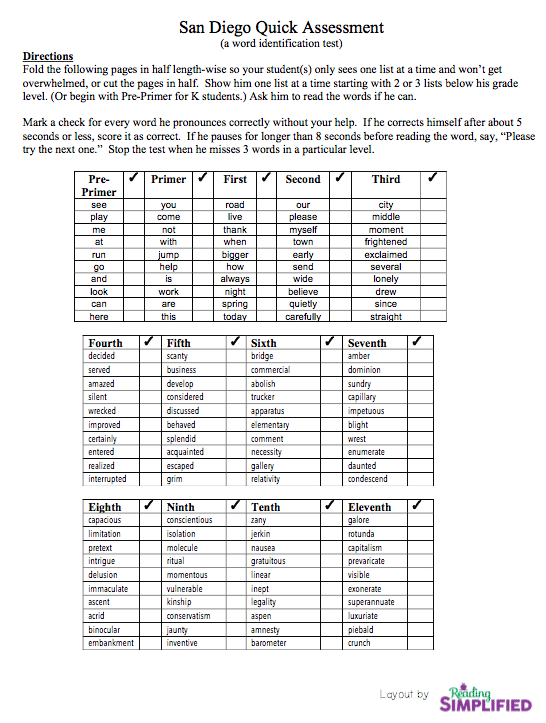 If a teacher has access to a thoroughly studied reading assessment, such as the
If a teacher has access to a thoroughly studied reading assessment, such as the
- Woodcock-Johnson Reading Mastery Test,
- Wechsler Individual Achievement Test, or the
- Test of Early Reading Achievement,
those would be excellent measures of Word ID.
When those assessments are unavailable, consider using the San Diego Quick Assessment. It's FREE! And it's norm-referenced, so you can compare each student with a national sample of U.S. children. The testing norms are a bit out-of-date, so don't treat it as an exact tool, but it's an effective substitute when you have no other norm-referenced measure of Word Identification.
Here's a FREE PDF version of the San Diego Quick Assessment that I've cleaned up to look sharp. 🙂
3rd Most Useful Diagnostic Reading Test
After students have gotten a couple hundred words memorized by sight, then fluency becomes a bigger concern. Fluency, like Word Attack and Word Identification, can be assessed rather quickly. Yeah!!
Once you have a student's proximate reading level from the Word ID test, select a graded, or leveled, passage that matches her Word ID level. Thus, if you have a 4th grader with a Word ID of 3rd grade, she should read a 3rd grade passage to determine her fluency–not a 4th grade passage.
Ask the student to read aloud the passage, time her, and note missed words. You want to calculate how many words she read correctly in 1 minute.
The easiest way to do this is make a note of of the spot she reaches at the 1:00 mark. Count up all the words up to her 1:00 mark, subtract any missed words, and you have her words correct/ minute (WPM) for that graded passage.
In addition, make a note of how fluent she sounded. How was her intonation and phrasing? If it was particularly choppy and robotic, that's important diagnostic information for next steps.
Most classrooms have some sort of graded or leveled readers that can be used for this type of fluency assessment, such as the DIBELS Oral Reading Fluency, Aimsweb CBM, Fountas and Pinnell Benchmark Assessment, or the DRA.
If you don't have access to these tools, then here are a few free, online options.
Sweet!!
- ReadWorks.org is an amazing free tool of online passages–both informational and literature-based passages. It's effective for a lot more than just passages for fluency assessments, but this can get ‘ya started.
- 1st – 8th grade passages from Pearson. They don't look pretty and they're too long, so just read a selection. However, they are likely leveled accurately.
- 1st – 5th Grade passages from K5Learning. These passages include harder and easier passages from within each grade level, so that can be helpful to get a more precise text into each child's hands.
- Over 140 passages for 1st – 5th from Mr. Nussbaum.com Afterwards, students can listen to the passages read aloud and take online quizzes, too, if that's fun or helpful.
I recommend selecting a site and using the passages from that site for all of your students for awhile so you learn to recognize the weaknesses and strengths of each passage. And you'll gain familiarity with how well certain passages are leveled, or not.
Finally, the question remains: how does a student's reading rate relate to other children her age?
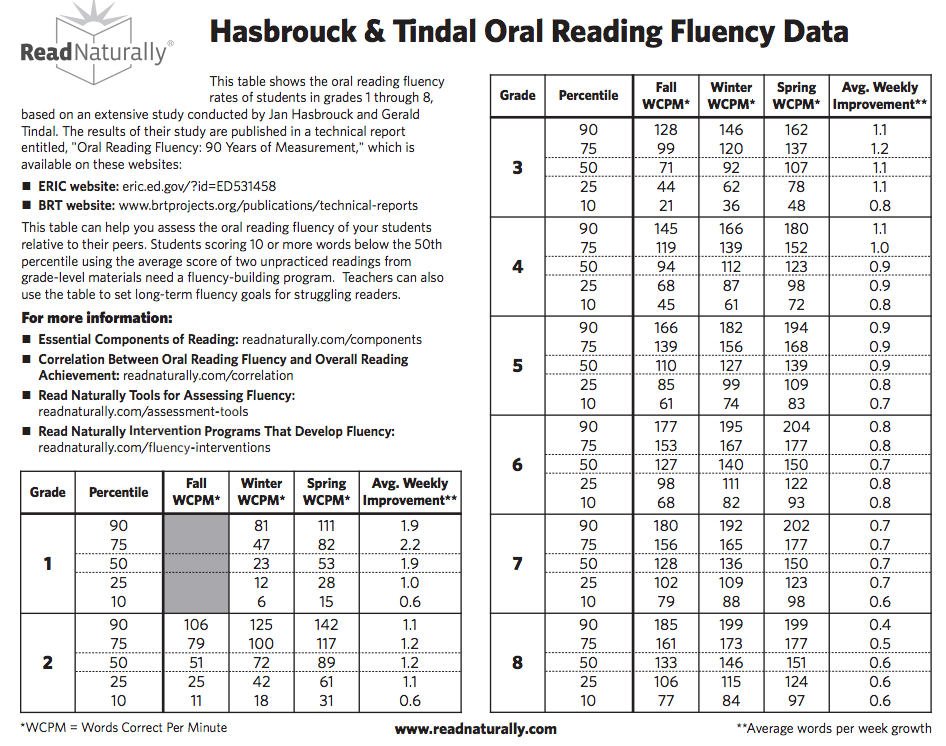 Well-known norms of oral reading rates for students K-8 have been created by Hasbrouck and Tindal. I suggest printing this out and storing it in a place you can refer to frequently.
Well-known norms of oral reading rates for students K-8 have been created by Hasbrouck and Tindal. I suggest printing this out and storing it in a place you can refer to frequently.
I heard Dr. Hasbrouck emphasize at a conference that fluency, in contrast to other reading skills, isn't necessarily better at faster and faster rates. In other words, she recommends that teachers guide students to aim for the 50th percentile mark for their given grade at the relevant time of the school year.
Beyond that goal, fluency probably isn't an important goal. Spend time instead on building vocabulary knowledge and knowledge of the world through wide reading and deep conversations in books the student enjoys.
How to Use the 3 Reading Tests
Not every student needs every test. I know…you're already over-testing, right?
A general and simple framework of how reading develops should help determine which tests should be given, and when.
Sound-based decoding is the foundation for other reading skills, including word identification. Word Identification usually is built upon that. The better one decodes, the easier it is for the brain to remember how words look by automatic recognition. Fluency is built on top of that word recognition skill.
Thus, if a child has poor sound-based decoding and poor word identification, I'm not really concerned about his fluency for now. If I'm pressed for time, I won't even measure his reading rate. Instead, I would focus relentlessly on his sound-based decoding skills using activities like Switch It, Read It, and Sort It, and lots of guided reading.
As decoding is shored up, word identification gradually improves. Once a student has sufficient knowledge of the code and strong decoding skills, she just needs reading practice to learn to recognize more and more words by sight automatically.
Similarly, fluency will follow along later after word identification, with wide reading and re-reading of short selections.
Thus, most students with a reading difficulty should at least be given a nonsense word reading test to examine their sound-based decoding. In K-3, I would give all my students a nonsense word reading test, actually. Many children with strong visual memories can memorize–using mostly visual skills and limited sound-based decoding–hundreds, and even thousands, of words without strong sound-based decoding.
However, eventually the visual-dominated memory taps out and these students start to dip in 3rd or 4th grade. Thus, I don't want to ignore early high flyers who appear to be running on all cylinders but who are actually headed for a fall when they need to be able to quickly read 10's of thousands of words to be a good reader, not just a couple thousand.
Tales from a Reading Coach
Across 20 years of a somewhat-crazy-obsession with how best to teach reading, I have taught many students how to read. I've heard hundreds of different parents' stories about how their child doesn't like to read; how their child doesn't do well in school; how their child's teacher is concerned about reading achievement; etc.
The stories are unique.
One pattern of their reading assessments, however, is not unique. Almost without fail, every student who is identified as struggling has a gap between certain higher reading skills and the lower-performing sound-based decoding, which is revealed with a nonsense word reading test.
Two recent case studies were particularly striking.
A 4th Grade Girl
A high-achieving 4th grade girl was identified by her teacher as having comprehension problems because she couldn't answer questions during class. Her mother was also concerned about attention to detail in reading, writing, and spelling.
The student's reading MAP score (a norm-referenced, standardized test) was at the 86%, which is surprisingly high for someone who appeared to have a comprehension problem.
A more complete reading assessment revealed a diverse pattern of reading sub-processes:
- 8th Grade Passage Comprehension
- Bader Informal Reading Inventory
- 7.4 G.E. (Grade equivalent) Passage Comprehension
- Woodcock-Johnson Reading Mastery
- 4.2 G.E. Word Identification
- Woodcock-Johnson Reading Mastery
- 3.9 G.E. Spelling
- Morrison-McCall Spelling Test
- 2.0 G.E. Word Attack
- Woodcock-Johnson Reading Mastery
Wow! This 4th grade student was able to comprehend 7th and 8th grade material in the context of sentences and paragraphs, but in isolation, her word identification was behind grade level.
Even more dramatic was the gap between her comprehension and her word attack (as measured by a nonsense word reading test)–she was performing like a 2nd grader at the beginning of the year!
I was amazed that she could even do so well with comprehension with such limited sound-based decoding skills! But while her case study is dramatic in the scope of the discrepancy, it is typical of the pattern. Word Attack weaknesses are the drag on the whole reading system.
After just 6 hours of instruction, her word attack went up 1.8 grade equivalents and her comprehension improved 1.1 months. By the end of tutoring of 12 hours of instruction with a focus sound-based decoding, she had improved rapidly in all reading fronts, as well as writing and classroom attention. !!
A 15 Year-Old Boy
I also was privileged to work with a freshman boy who had just been identified by an private psychologist as being dyslexic. He fit a pattern like the child above–word identification slightly behind grade level, but word attack significantly behind grade level. Unfortunately, he didn't have the compensatory abilities to have above-grade level comprehension.
Here are some of his notable scores from initial testing:
- 1.8 G.E. (Grade Equivalent) Non-Word Decoding
- 37% for Word Identification
- Low average Reading Rate
For 7 hours of 1-on-1 instruction, we worked together with classic Reading Simplified activities, such as Switch It, Read It, Sort It, guided reading, and re-reading for fluency. Then I did a couple of reading tests to give a mid-point assessment of his progress. And a lot of changes had occurred:
- 70% Word ID (Wide Range Achievement Test-3)
- 140 Words Per Minute
- Passed nonword dyslexia test at Lexercise.com
I kept working with him but that was a big jump after just 7 sessions! To go from the 37% in Word ID to the 70% in Word ID is huge and was dependent on him reorganizing his sound-based decoding abilities.
What Can a Nonsense Word Reading Test Do for Your Students?
Do you have students who lack motivation to read?
Those who struggle to get their ideas down on paper?
Those who don't want to read aloud?
Those who seem brighter than their reading tests would suggest?
These students who are popping into your mind right now may very well be weak in sound-based decoding. But you may doubt that's true…”They sound pretty good when they read aloud…..I only have to help them with a few words.”
Yes, a sound-based decoding ability can be easily masked through lots of practice, grit, and cleverness. Nevertheless, problems will arise related to reading, writing, or school achievement in general when a student's decoding lags behind his grade level.
How will you know what the source of your students' reading problems unless you test them?
A 2-5 minute nonsense word test is a good place to start!
Please consider giving one of the free nonsense word reading tests listed above, especially one of the norm-referenced ones.
If they aren't at grade level or well above grade level (my preference), then it's likely that they will significantly benefit from improved sound-based decoding. The good news is that boosting that isn't as complicated or drawn-out as you might think.
We've streamlined the teaching of reading down to just 3 core activities in a guided reading framework that is easy to implement and flexible. Once you've given the nonsense word reading test–and perhaps the Word ID and fluency measures, head to the following 2 in-depth posts to learn what you need to do to change those low nonsense word reading scores into strong scores:
- The Reading Simplified system in brief
- Small Group Guided Reading Structure Accelerated Reading (and for Less Stress)
Loving Those Comments!! 🙂 🙂
And please comment with your experience with these tests!
Or, do you have a diagnostic question about a student or two? Your teacher colleagues and I would love to hear from you so please comment below.


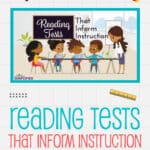
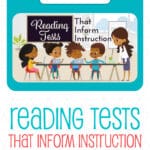
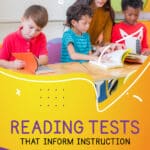

Making connections ??
Sweet, Sharon! 🙂
Hey Marnie, I have a question about the Word ID test. I have used the San Diego Assessment before and I am wondering how you read the score? If a student misses one word on the first grade list and then 4 words on the 2nd grade list, which word level would you use for instruction? Also, does the grade level of the word list indicate where students should be at the beginning of that grade level or the end?
Hi Jennifer! Here’s more details about reading the score:
Where possible, determine a student’s Frustration, Instructional, & Independent
Level.
Frustration = 3 errors ___________________ Level
Instructional = 2 errors ___________________ Level
Independent = 1 error ___________________ Level
Thus, the student will have a Frustration level, an Instructional level,
& an Independent Level.
But based on your example, there’s no perfect fit, right? This is a broad brushstroke-type test, so it’s fine to use your judgement on issues like this.
I would label that score array as Instructional at “Early 2nd grade” since the student is technically at Frustration with the entire 2nd grade list. However, the great 1st grade score should keep him/her out of 1st grade as Instructional. Does this fit with other data you have?
Yes, that is the direction that I was going. 1st grade seemed like it would not be enough of a challenge, so we will start slow with the 2nd grade list.
Thanks Marnie 🙂
Oh good! 🙂
Marnie, how do the instructional and frustration levels on the San Diego assessment correlate with what level to start students on in the Reading Simplified guided reading passages? I’m guessing you start guided reading at the instructional level? Or is it case by case?
Good question, Jessica! The Streamlined Pathway is about building sound-based decoding skill. We determine where to start students on our Pathways mostly on the basis of their reading sub-tests info, as in the Snapshot Assessment.
If a student knows most consonants, then we start on the first grade pathway at least. (If not, they start at the K Streamlined Pathway.) If the student has a reading level of 2nd grade or above (as judged by the San Diego Assessment or other reading level assessment) we start with the 2nd grade Streamlined Pathway.
Most everyone starts at the first step of their respective Streamlined Pathway. Even if a child is more advanced than 2nd grade reading level, if they are struggling at all, they likely have random phonics and decoding skill holes here and there so we still go from the beginning of the Streamlined Pathway for their instruction. Of course, some may move very rapidly through those steps if they can.
Then, if you asking about choosing text levels, we’re still mostly choosing mostly decodable texts while students are at the beginning of the Streamlined Pathway. Leveling these is imprecise so we just select easier or harder phonics/decoding texts or passages as we estimate will challenge them.
After a few weeks of classic Reading Simplified decoding instruction, the older readers at the higher level will read 2 texts each day–a bit from the mostly decodable text of the sound they’re targeting and a text that’s instructionally challenging. THEN, the San Diego test can inform our selection.
Does this make sense?
Good afternoon Marnie! I found this article of yours very relevant to the academic paper that I am working. What reading comprehension test do you recommend for English learners 4th grade mostly are in emerging and developing levels (English proficiency). I am trying to find the most appropriate test as my research instrument. Thank you!
Blessie, I don’t think I know a good answer off-hand. As you continue to look further, consider what you want the comprehension test to measure. Do you want a reading level? Do you want a standardized, norm-referenced measure or an informal inventory? Comprehension tests are a broad umbrella and each type yields slightly different information.
Good Morning Marnie! What role does automaticity/fluency play with a nonsense word assessment (DIBELS type)? I have students who can read nonsense words accurately when sounding them out (using a Quick Phonics Screener) but cannot meet the benchmark for a nonsense word fluency assessment. I’m reluctant to move them forward when they cannot meet the benchmark on the NWF assessment, but then I have kids get stuck in CVC because of it.
Our rule of thumb with basic code is to move children to the next step of the pathway and expose more code if they are accurate about 70% of the time. The code we’ve taught will continued to be covered because our materials are cumulative. We also have review packets after teaching a couple of new steps. In these we often have word lists and activities to continue to work on automaticity of code that is already taught. And of course we do this with games too like Rainbow Land, or Steal It.